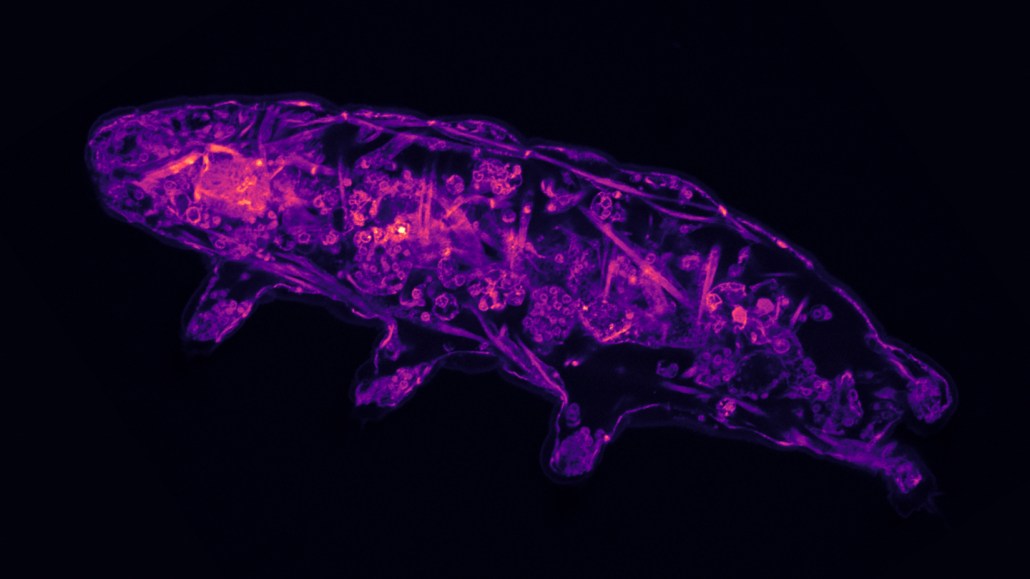
Tardigrades, like this one stained with a dye to show its internal organs, can survive extreme conditions while dormant. Scientists have discovered the chemical signal that causes the animals to hunker down and wake up again.
A.L. Smythers et al/ PLOS ONE 2024 (CC-BY 4.0)
Researchers have discovered a molecular sensor that tells tardigrades it’s time to toughen up.
The tiny eight-legged animals, also known as water bears or moss piglets, are nearly invincible when dormant. When times get tough, the microscopic invertebrates curl into a ball called a tun. They pull in their legs, jettison water, turn their insides to glass, and slow their metabolism to imperceptible levels (SN: 12/16/15). In that state, tardigrades are able to withstand completely drying out, trips into space, X-rays and other extreme insults, but aren’t entirely bulletproof (SN: 7/13/22; SN: 6/2/21).
“Tardigrades aren’t extremophiles, they’re extremo-tolerant,” says Derrick Kolling, a chemist at Marshall University in Huntington, W.Va.
Chemical changes called oxidation to the amino acid cysteine trigger the tun state, Kolling and colleagues discovered. Reversing that oxidation process brings tardigrades out of dormancy, the team reports January 17 in PLOS One.
Scientists have long wondered what prompts tardigrades’ entry and emergence from the tun state, says Hans Ramløv, a comparative physiologist at Roskilde University in Denmark who was not involved in the study. Knowing that cysteine oxidation is the key is “inspirational,” but also, “it is a little bit irritating for myself, because I have always claimed that the transformation was passive, and now I can see that it is definitely not passive.”
The finding helps explain some aspects of water bear biology, and perhaps that of other organisms that go into suspended animation, when metabolism drops to nothing and the animals are essentially dead, Ramløv says. For instance, tardigrades have very high metabolism when they emerge from dormancy. That may be because they are actively reversing cysteine oxidation and repairing damage caused by oxidation, he says. But a fundamental question remains. “It obviously does not explain how you can stop metabolism and die and restart metabolism and live.”
The project came about “on a whim,” Kolling says. “We were curious about tardigrades. They’ve been in the news quite a bit.” So he told his lab, “tardigrades are easy to get. Let’s get some and let’s put them in an instrument we have here.” That instrument was an EPR spectrometer. Scientists use it to study atoms and molecules that have unpaired electrons.
Using the instrument, Kolling and colleagues saw that as Hypsibius exemplaris tardigrades entered the tun state, levels of superoxides shot up. Superoxides are molecules of oxygen that have had an electron added, leaving one electron unpaired and ready to react with other atoms and molecules. The unstable chemicals, sometimes called reactive oxygen species or free radicals, can damage proteins and other components of cells.
But superoxides can also be used to send signals, says Leslie Hicks, a chemist at the University of North Carolina at Chapel Hill. Her lab teamed with Kolling’s to decipher what was happening to the tardigrades. One of the researchers’ first steps was to expose tardigrades to a type of stress they wouldn’t normally encounter.
“Let’s throw hydrogen peroxide at the bears and see if they can form tuns as a result of that stress,” Hicks recalls telling her colleagues. The team tested various concentrations of hydrogen peroxide, a powerful oxidizing chemical. Sure enough, the tardigrades went into tun mode in dilute hydrogen peroxide. Removing the hydrogen peroxide woke the water bears up again. That told the researchers that oxidation was an important signal for entering and leaving dormancy.
Drilling down further, Hicks and colleagues examined oxidation of cysteine, one of the amino acids that make up proteins in living things. Exposure to hydrogen peroxide or other unstable chemicals can cause chemical changes to cysteine, some reversible and some not. In turn, those changes can alter the structure and enzyme activity of proteins.
Blocking cysteine oxidation prevented tardigrades from forming tuns triggered by exposure to high levels of salt or sugar, the team found. Blocking cysteine oxidation also wiped out the tardigrades’ ability to survive freezing, although the resilient little animals don’t form tuns when frozen. That suggests that cysteine oxidation may be an important player in all the water bears’ survival mechanisms, Hicks says.
The researchers didn’t test drying, says Kazuharu Arakawa, a systems biologist at Keio University in Fujisawa, Japan, not involved in the study. He’s curious to find out whether other species of tardigrades that can tolerate drying without forming tuns also rely on oxidation. Oxidation may be important for other species unrelated to tardigrades, too, Arakawa says. For instance, other researchers have shown that oxidation is important for some midges to survive drying out.






